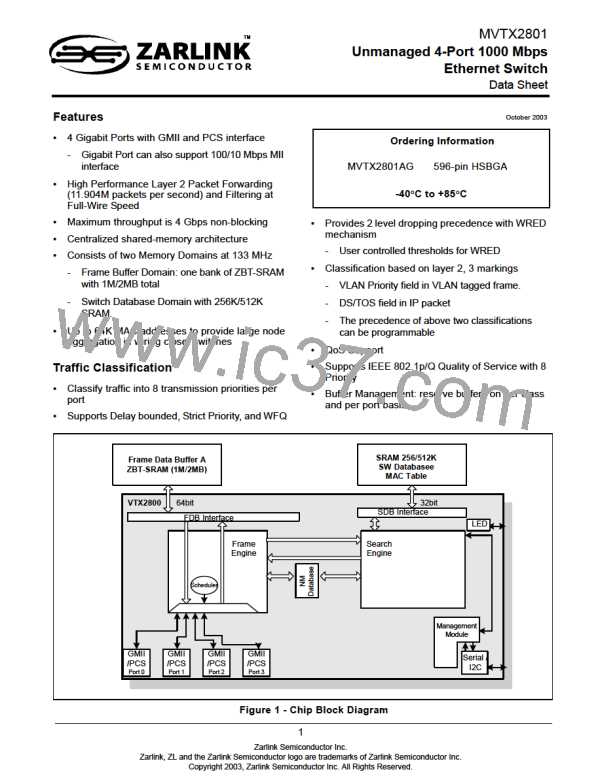MVTX2801
Data Sheet
5.3.2 Learning
The learning module learns new MAC addresses and performs port change operations on the MCT database. The
goal of learning is to update this database as the networking environment changes over time. Learning and port
change will be performed based on memory slot availability only.
5.3.3 Aging
Aging time is controlled by register 400h and 401h.
The aging module scans and ages MCT entries based on a programmable “age out” time interval. As we indicated
earlier, the search module updates the source MAC address and VLAN port association timestamps for each frame
it processes. When an entry is ready to be aged, the entry is removed from the table.
5.3.4 Data Structure
The MCT data structure is used for searching for MAC addresses. The structure is maintained by hardware in the
search engine. The database is essentially a hash table, with collisions resolved by chaining. The database is
partially external, and partially internal, as described earlier: the first MCT entry of each linked list is always located
in the external SRAM, and the subsequent MCTs are located internally.
6.0 Frame Engine
6.1 Data Forwarding Summary
•
Enters the device at the RxMAC, the RxDMA will move the data from the MAC RxFIFO to the FDB. Data is
moved in 8-byte granules in conjunction with the scheme for the SRAM interface.
•
•
A switch request is sent to the Search Engine. The Search Engine processes the switch request.
A switch response is sent back to the Frame Engine and indicates whether the frame is unicast or multicast,
and its destination port or ports.
•
A Transmission Scheduling Request is sent in the form of a signal notifying the TxQ manager. Upon
receiving a Transmission Scheduling Request, the device will format an entry in the appropriate
Transmission Scheduling Queue (TxSch Q) or Queues. There are 8 TxSch Queues for each Gigabit port,
one for each priority. Creation of a queue entry either involves linking a new job to the appropriate linked list
if unicast, or adding an entry to a physical queue if multicast.
•
•
When the port is ready to accept the next frame, the TxQ manager will get the head-of-line (HOL) entry of
one of the TxSch Qs, according to the transmission scheduling algorithm (so as to ensure per-class quality
of service). The unicast linked list and the multicast queue for the same port-class pair are treated as one
logical queue.
The TxDMA will pull frame data from the memory and forward it granule-by-granule to the MAC TxFIFO of
the destination port.
6.2 Frame Engine Details
This section briefly describes the functions of each of the modules of the MVTX2801 frame engine.
6.2.1 FCB Manager
The FCB manager allocates FCB handles to incoming frames, and releases FCB handles upon frame departure.
The FCB manager is also responsible for enforcing buffer reservations and limits. The default values can be
determined by referring to Chapter 8. In addition, the FCB manager is responsible for buffer aging, and for linking
unicast forwarding jobs to their correct TxSch Q. The buffer aging can be enabled or disabled by the bootstrap pin
and the aging time is defined in register FCBAT.
16
Zarlink Semiconductor Inc.

 ZARLINK [ ZARLINK SEMICONDUCTOR INC ]
ZARLINK [ ZARLINK SEMICONDUCTOR INC ]